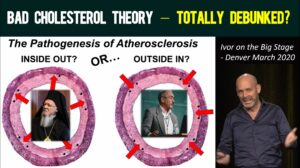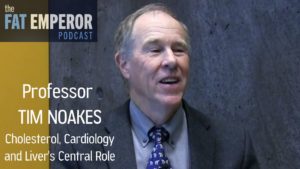
Had great fun in past couple of days wrangling about the root causes of Atherosclerosis and Vulnerable plaques with @PauliOhukainen and @brianedwardsmd; from-the-hip, freestyle and in-yer-face stuff – these guys are great sparring partners!
I drafted out the above Root Cause Diagram to pictorially represent a personal view of Atherosclerosis, and perhaps help with the discussion; there are copious references for all causal links shown, and I’ll reference them as time goes on and people add to my bulging archive of papers. At the bottom of this post I will include firstly a couple of tasters for GGT and Ferritin, because these don’t get a lot of press (Insulin, BP etc are all widely accepted as major drivers, not just associative); I’ll add to the full list over time….
In complex multi-factorial problem solving, when an issue arises and becomes serious, one must find the addressable root cause in order to develop an acceptable solution. My definition of engineering Root Cause (RC) has consolidated over the past twenty years, and ended up roughly as follows:
“Following an excursion, Root Cause is the interplay between (A) The most direct mechanistic driver of the issue (usually situated early in the root cause chain diagram), and (B) the most addressable factor to achieve acceptable solution (usually it will be the factor that has actually shifted and precipitated the excursion)”. There may be multiple coincident factors that are implicated as worthy of Root Cause status btw – especially in the nasty issues, and this is certainly one of those.
Which brings us to our Atherosclerosis/CVD “Excursion” in the past century. This is certainly a multi-causal and highly interactive problem, no one would argue with that. Simplified, there are broadly two schools of thought:
(1) The truest RC is so-called “Cholesterol”, with it’s causal influence best measured as the number of APoB 100 containing Lipoproteins (i.e. ApoB or LDL-P). I agree that this is a critical factor influencing the disease, and it can be influenced downwards if needed which will certainly mitigate the progression. In short, the first part of RC (A) is met. Now to part (B) – is it the factor that has changed to precipitate the problem, and is it the most addressable? Well, it has certainly changed with the modern diet, and this can be addressed very well in most cases, and drugs too, so it is a good RC factor for sure. The philosophical challenge is whether it is inherently the true addressable root cause that has changed, in and of itself, and whether drugs are the true solution (after all, no-one is suggesting that the problem occurred because previous historical drug use was discontinued for a while, right?
(2) The truest RC is excess Sugar/Carb, driving a catastrophic milieu of dysfunction, and when this is resolved then the ApoB reverts to being non-significant in the scheme of things. This would fit both (A) and (B) quite acceptably. Of course there are other things to address (e.g. w6/w3 balance, smoking, exercise etc etc, but let’s focus on the biggy here).
This post wouldn’t be complete without the Quebec study (sub group of NON-Diabetics, so most interesting):

The embryonic references list:
GGT and library: http://healtheiron.publishpath.com/GGT-science-library
Ferritin, Ferritin Recent FeAST Trial, http://healtheiron.publishpath.com/iron-science-library
Nitrous Oxide BP / Ox Plaque from @Mommy_md: Triggering Oxidative Stress…
And Vladimir’s excellent, alternative (and correct?) mechanism for Atherosclerosis LDL ingress: http://www.thefatemperor.com/blog/2014/10/29/all-atherosclorosis-theoriticians-should-peruse-this
And a piece on AGE’s and Atherosclerosis from @iainlane88 this eve: http://www.cardiab.com/content/1/1/1
And lack of Vitamin D – haven’t even put that on the RCD yet! https://www.researchgate.net/publication/264989019_Vitamin_D_and_atherosclerosis







